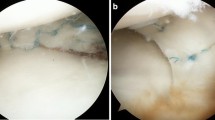Abstract
Introduction
In recent years, three-dimensional (3D) MRI has been utilized to detect meniscal tears and has displayed several advantages over 2D MRI. The diagnostic performance to discriminate the type of meniscal tears by 2D MRI (sagittal and coronal images) and axial images from 3D MRI datasets has not been reported yet. The aim of the present study is to evaluate the efficacy of the axial reconstructed images from 3D MRI datasets for the morphological diagnosis of meniscal tears of the knee.
Materials and methods
Seventy-four menisci in 37 patients who underwent arthroscopic surgery of the knee were studied. All patients were examined by 2D sagittal and coronal MRI and by axial images from 3D MRI datasets prior to surgery. First, we compared the diagnostic performance for meniscal tears by 2D sagittal and coronal MRI to that by axial images from 3D MRI datasets as judged by arthroscopic findings. Second, we compared the correlation of tear types presumed from 2D sagittal and coronal MRI to arthroscopy with those presumed from axial images from 3D MRI datasets to arthroscopy.
Results
For the diagnostic performance of meniscal tears on 2D MRI, the sensitivity, specificity and accuracy were 93.5%, 88.4% and 90.5%, respectively. On axial images from 3D MRI, the sensitivity, specificity and accuracy were 96.8%, 79.1% and 86.5%, respectively. Nine cases were false-positive on axial images, while 5 cases were false-positive on 2D images. Correlations to arthroscopy were 100% by both scans for longitudinal tears and discoid meniscus tears. Only 29% were correctly diagnosed by 2D sagittal and coronal images for radial tears, however, all radial tears could be correctly diagnosed by axial images. All horizontal tears were correctly diagnosed on 2D sagittal and coronal images, while none of the horizontal tears could be correctly diagnosed from axial images.
Conclusion
Axial images from 3D MRI datasets were useful in the diagnosis of radial tears, but two limitations are noted concerning the use of axial images. First, medial menisci should be carefully read on axial slices because of the relatively high rate of false-positives on medial menisci. Second, axial images cannot discriminate horizontal tears from other types of meniscus tears.




Similar content being viewed by others
References
Biedert RM (1993) Intrasubstance meniscal tears. Clinical aspects and the role of MRI. Arch Orthop Trauma Surg 112:142–147
Bin SI, Kim JM, Shin SJ (2004) Radial tears of the posterior horn of the medial meniscus. Arthroscopy 20:373–378
Crues JV III, Mink J, Levy TL, Lotysch M, Stoller DW (1987) Meniscal tears of the knee: accuracy of MR imaging. Radiology 164:445–448
Elvenes J, Jerome CP, Reikeras O, Johansen O (2000) Magnetic resonance imaging as a screening procedure to avoid arthroscopy for meniscal tears. Arch Orthop Trauma Surg 120:14–16
Fischer SP, Fox JM, Del Pizzo W, Friedman MJ, Snyder SL, Ferkel RD (1991) Accuracy of diagnoses from magnetic resonance imaging of the knee. A multi-center analysis of one thousand and fourteen patients. J Bone Joint Surg Am 73:2–10
Gay SB, Chen NC, Burch JJ, Gleason TR, Sagman AM (1993) Multiplanar reconstruction in magnetic resonance evaluation of the knee. Comparison with film magnetic resonance interpretation. Invest Radiol 28:142–145
Guckel C, Jundt G, Schnabel K, Gachter A (1995) Spin-echo and 3D gradient-echo imaging of the knee joint: a clinical and histopathological comparison. Eur J Radiol 21:25–33
Jones RS, Keene GCR, Learmonth DJA, Bickerstaff D, Nawana NS, Costi JJ, Pearcy MJ (1996) Direct measurement of hoop strains in the intact and torn human medial meniscus. Clin Biomech 5:295–300
LaPrade RF, Burnett QM II, Veenstra MA, Hodgman CG (1994) The prevalence of abnormal magnetic resonance imaging findings in asymptomatic knees. Am J Sports Med 22:739–745
Magee T, Shapiro M, Williams D (2002) MR accuracy and arthroscopic incidence of meniscal radial tears. Skeletal Radiol 31:686–689
Mink JH, Levy T, Crues JV III (1988) Tears of the anterior cruciate ligament and menisci of the knee: MR imaging evaluation. Radiology 167:769–774
Quinn SF, Brown TF (1991) Meniscal tears diagnosed with MR imaging versus arthroscopy: how reliable a standard is arthroscopy? Radiology 181:843–847
Reicher MA, Bassett IW, Gold RH (1985) High resolution magnetic resonance imaging of the knee joint: pathologic correlations. AJR 145:903–909
Reicher MA, Rauschning W, Gold RH (1985) High resolution magnetic resonance imaging of the knee joint: normal anatomy. AJR 145:895–902
Silva I, Silver DM (1988) Tears of the meniscus as revealed by magnetic resonance imaging. J Bone Joint Surg Am 70:199–202
Solomon ST, Totty WG, Lee JKT (1989) MR imaging of the knee: comparison of three-dimensional FISP and two-dimensional spin-echo pulse sequences. Radiology 173:739–742
Tuckman GA, Miller WJ, Remo JW, Fritts HM, Rozansky MI (1994) Radial tears of the menisci: MR findings. AJR 163:395–400
Author information
Authors and Affiliations
Corresponding author
Rights and permissions
About this article
Cite this article
Ohishi, T., Takahashi, M., Abe, M. et al. The use of axial reconstructed images from three-dimensional MRI datasets for morphological diagnosis of meniscal tears of the knee. Arch Orthop Trauma Surg 125, 622–627 (2005). https://doi.org/10.1007/s00402-004-0792-0
Received:
Published:
Issue Date:
DOI: https://doi.org/10.1007/s00402-004-0792-0




